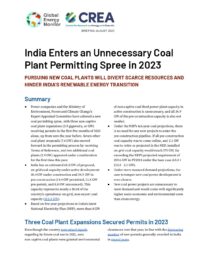According to a new analysis by Global Energy Monitor (GEM) and Center for Research on Energy and Clean Air (CREA), close to 11.5 gigawatts (GW) of coal power capacity under development moved forward through various approval stages in the first five months of 2023. India permitted about 3.9 GW of coal projects and 7.6 GW of coal projects received Terms of Reference, moving them one step closer to permits.
Despite the concerning uptick, the number of projects in development (announced, pre-permit, and permitted coal capacity including captive and non-captive) has shrunk by a staggering 85% since 2014, from 250 GW to 36 GW.

India’s coal approval spree in 2023 marks a change in India’s energy transition pattern. Last year, India did not approve any new coal power plants for the grid, which was in line with the global trend of moving away from the dirty, expensive, and outdated energy.
Flora Champenois, Research Analyst at Global Energy Monitor (GEM)
India is actively developing 65.3 GW of coal power capacity. Of this, 30.4 GW of coal power capacity is under construction and 35 GW is in various pre-construction phases (14.4 GW permitted, 11.8 GW pre-permitted, and 8.8 GW announced).
The analysis notes that India’s current proposals overshoot the already significant coal capacity expansion projected in the country’s energy plan.
Based on five-year projections in India’s latest National Electricity Plan (NEP 2023), more than 8 GW of non-captive coal-fired power plant capacity in active construction is unnecessary, and all 34.9 GW of the pre-construction capacity is also not needed.
Under the NEP’s ten-year coal projections, there is no need for any new projects to enter the pre-construction pipeline. If all pre-construction coal capacity was to come online, and 2.1 GW was to retire as projected in the NEP, installed on-grid coal capacity would reach 275 GW, far exceeding the NEP’s projected requirement of 259.6 GW in FY2032 under the base case.
Sunil Dahiya from Centre for Research on Energy and Clean Air (CREA) said, "Electricity demand estimated in India’s National Electricity Plan has always been over-projected compared to real demand. In the past, this has led to billions of dollars worth of coal power plants turning into non-performing assets (NPA). The ongoing push for more coal power proposals already exceeds requirements and therefore could again lead to more stranded assets."
Dahiya further added, "Going ahead with these projects will not only worsen financial standing but also lead to climate, air pollution, and health disasters in the future. Adequate and efficient actions need to be taken now to avert these disasters."
India has the opportunity to push for a stronger outcome and accelerate the global coal to clean energy transition at the G20 leaders’ summit in Delhi in September, addressing the twin needs of energy access and energy security. An orderly move towards clean energy will also help confront the climate crisis, raise economic productivity, create jobs, and improve environmental and public health outcomes. Simultaneously investing in both coal and renewables will only result in a messier energy transition for India.
“The country has the opportunity to set the right example and push for a strong coal-to-clean outcome at the G20 leaders’ summit in Delhi in September,” said Champenois.

